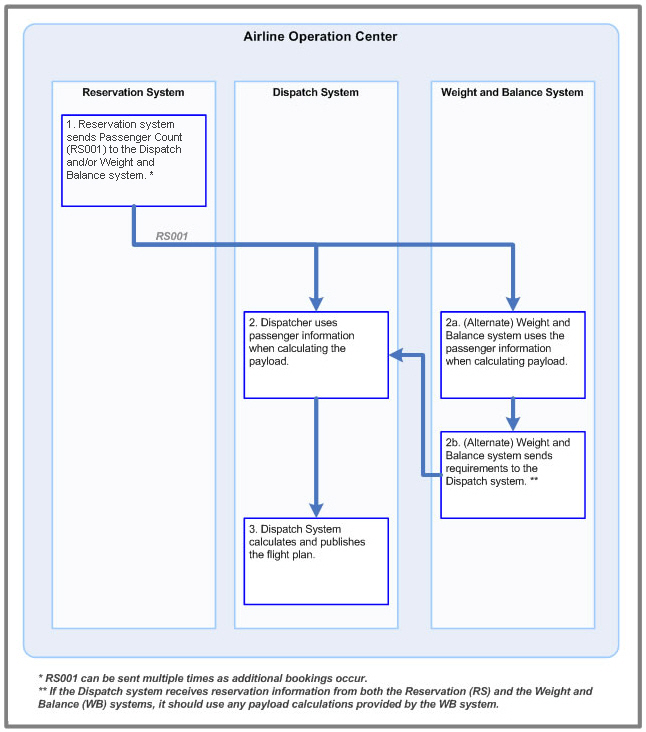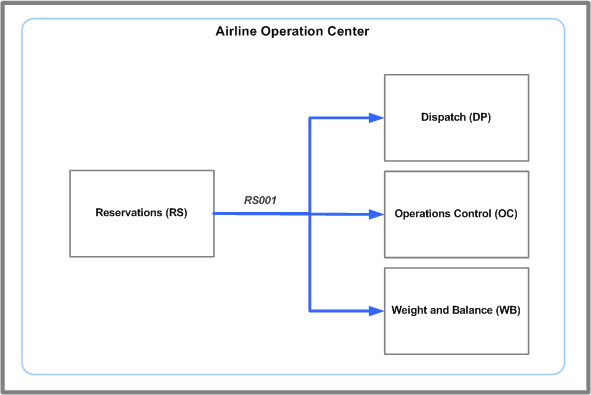
Reservations
System and Message Overviews
Document Version: 5.5
Date: May 26, 2015
Document Revision History
The following revision history table reflects all substantive changes to this document.
| Date | Description of Updates Made |
04-August-08 |
No changes since previous release. |
30-August-10 |
Updated links for new Bookshelf directory structure. |
| 12-September-11 | New XSD. New RS001 - rebuilt to cover all versions of RS002 (RS002 removed). |
| 15-November-11 | New XSD. Updated RS001 - Class1 made optional. |
| 23-July-13 | New XSD. |
| 3-March-14 | New XSD. |
| 26-May-15 | New XSD. Common.xsd added flightKey which had a trickle-down effect causing this xsd to be updated. |
Table Of Contents
1.4 Key Concepts
1 Introduction
This document defines the interfaces which govern the interchange of data between a Reservation system and other systems within an Airline Operation Center (AOC). Each AOC interface is represented by a message described in an associated XSD (XML Schema Definition). The XSD defines and enforces the required, optional, and conditional data that can be included in a message.
Reservation systems are used for passenger booking and tracking. Reservations can also be used to input aircraft movement.
1.1 Audience
The intended audience for this document includes existing and potential Jeppesen customers, integration partners, and personnel with roles associated with application architecture, application development, system testing, implementation, and application support within Reservations.
1.2 Scope
This document discusses the Reservation messages currently supported by the Jeppesen Solution Integrator. Each message description includes the following:
- Overview for common message uses within an AOC
- Message Version Summary listing all available versions of each message
- Links to the message specifications including direct links to XSD documentation, where you can explore the XSD hierarchy and interface specifications in a navigable HTML format
- Links to the XSD source code
- Links to sample XML messages for each AOC message
Other data interfaces or formats not included in this document will be considered custom and not supported.
1.3 XML Schema/XSD
The XML schema for this ICD is published in the following file: Reservations.xsd
1.4 Key Concepts
1.4.1 Reservation Data Use in Other AOC Systems
Reservation data includes the number of passengers by class of service. This information is used by the following AOC systems:
- Dispatch – used in payload calculations when calculating a flight plan
- Operations Control – used to support decision making related to cancellations and other day-of operations (for example, an airline may decide to delay a flight with only 50 passengers rather than delaying a flight with 250 passengers)
- Weight and Balance – used to plan out the payloads
- Flight Planning – used to calculate the payload
- Schedule Planning – used to decide flight frequencies and other scheduling items
Additional Information: reservation data and payload calculations
A passenger count is often used in payload calculations when creating a flight plan. An average weight is typically associated with each passenger, often accounting for seasonal changes and destinations. For example, passengers typically pack fewer clothes in warmer months, and therefore their total weight (passenger + luggage) will be a few pounds lighter.
Depending on the AOC configuration, the passenger information is either sent to the Dispatch or the Weight and Balance system for payload calculations. Either way, the payload calculation is eventually routed to the Dispatch system for use in the flight plan calculations.

Figure 1. Example passenger data relationship to payload
2 Message Summary
Table 2-1 lists the messages that can be sent or handled by the application. The messages originated by this application (messages that begin with “RS”) are further discussed in Section 3 AOC Interface Messages.
Table 2-1 Message Summary
3 AOC Interface Messages
The following messages are processed by the Reservations system.
3.1 RS001 – Passenger Counts
3.1.1 Message Overview
Depending on system configurations, the Reservations System can send passenger count data for display in the Dispatch System, or based on passenger count information, the system may be configured to calculate payload prior to flight calculation.
For example, Flight 1234 and Flight 555 both fly from SFO to LAX, departing one hour apart. Flight 1234 has only twenty passengers two hours to departure and Flight 555, the second flight to depart, still has fifty available seats. Flight 1234 is cancelled and the twenty passengers are moved to Flight 555. The PassengerCounts message is re-sent prior to flight 555 to account for the twenty additional passengers.
In the above example, the PassengerCounts data also allowed the operations control to see that the second flight (Flight 555) had capacity for the additional passengers.
3.1.2 Message System Flow
This message interacts with the systems as shown in Figure 2.

Figure 2. RS001 message system flow
3.1.3 Message Details
The following table provides details on the message version and includes links to the message’s technical specification.
Message Version |
RS001 v1 |
Message Header Details |
msgName: RS001 |
Message Specification |
|
Defined in XSD |
|
Sample Messages |
|
| Message Version History |
Version 1
* Rebuilt to cover all versions of RS002 (RS002 removed) / Class1 made optional. |